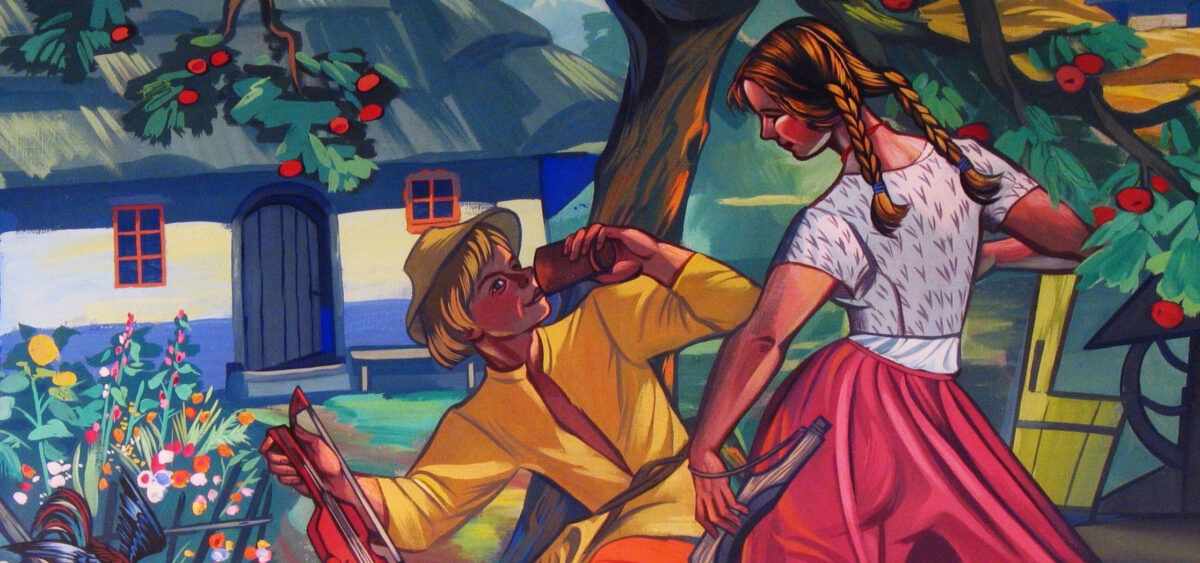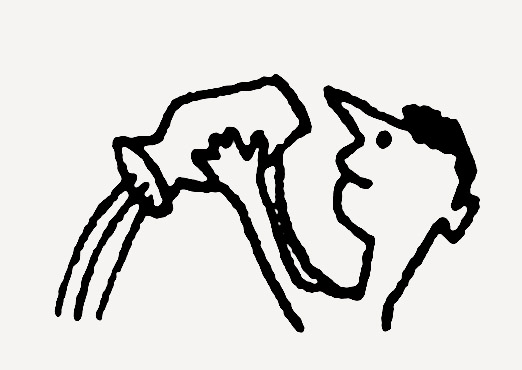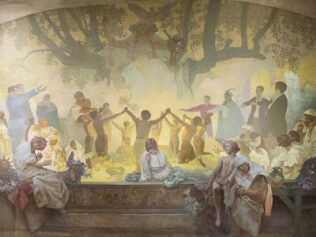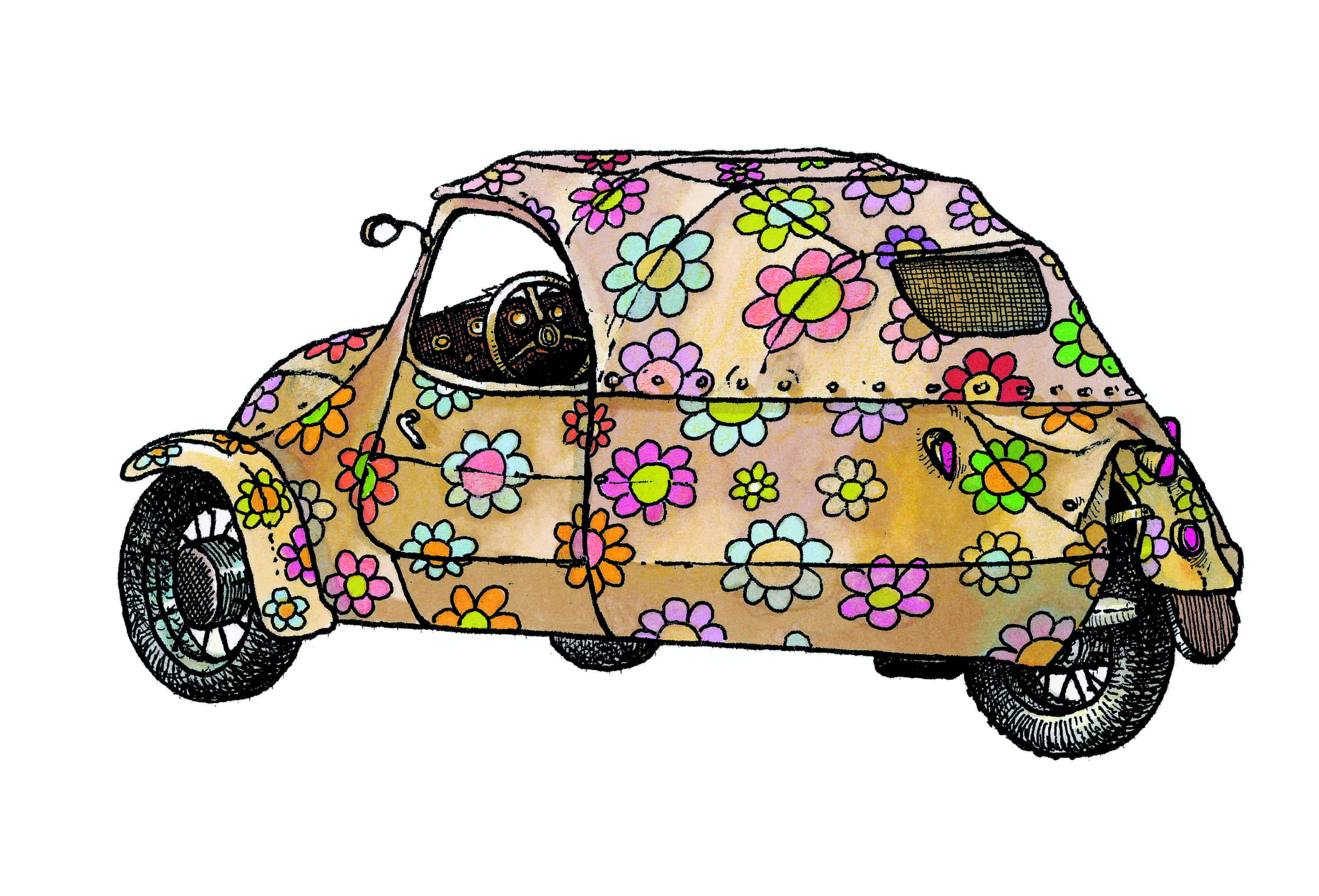
Far, far away there lives a little girl who spends entire days playing in the forest. When the evening arrives, she happily falls asleep in the sweet embrace of a bear. The bear’s name is most probably Misha, but let’s not get distracted. The most important thing is to feel the Slavic power within.
“Health to your bright thoughts!” So begins the e-mail that will become my ticket to a better world. No need for a visa or to book a flight. I don’t even have to speak Russian. As luck would have it, a better world is being built near to my hometown. Just a dozen or so kilometres up the motorway, a northbound exit allows me to leave the matrix.
I reach the last house on the outskirts of a picturesque village and am greeted by women in long robes, as well as bearded men. I’m dressed just like them and wear no make-up. Showing up at the agreed time to the address that I was sent by e-mail, I introduce myself as a happy mum and an unhappy citizen of the technocratic world, pining for nature and a different way of life. It’s not a lie, but it’s not exactly the truth either.
Fortunately my hosts kick things off in a similar fashion. They mostly live in big cities, where they feel a distinct lack of belonging, as if they’re in a foreign land. Each of them will soon own a plot of land on the vast grounds here. For now, the grounds belong to a couple who have lived here for three years, residing in an old home that used to belong to some Germans. The couple will move out as soon as their family homestead is built, just a few metres up the hill.
With all the participants gathered together, we walk down a path to a plot of land that will be part of the future settlement. There is a simple wooden house, without running water or electricity. One day it will be turned into a school. Inside, long-haired women in full-length dresses prepare vegan dishes, while bearded men set tables and seats outside. We sit in a circle, where we’re joined by many children.
“Peace to your bright thoughts,” the organizer of our gathering begins, and I realize that the world I used to know is about to collapse.
On the harmfulness of jeans
The Anastasians are easily discovered upon venturing into the more exotic realms of YouTube. You can start, for example, with a documentary on Vissarion, the Ukrainian policeman who one day felt Jesus inside him. This transformational experience led him to become a spiritual leader, a guru and a god for tens of thousands of people, who abandoned their lives and moved into eco-villages in a far-flung corner of Siberia. Finding Jesus is a strong tradition in the former Eastern Bloc – according to some estimates, there are now around 18 reincarnated Christs in Russia alone. When the Russians waved goodbye to communism, an ideological vacuum was created, soon filled by New Age movements and increasingly inspired by Slavic folklore. These new Jesuses have been joined by all sorts of spiritual teachers and gurus, along with throngs of bards, soothsayers and tellers of tales. This is, of course, a continuation of an old Russian tradition – just think of the Old Believers, the Filippians or the Skoptsy.
Next, YouTube suggests other videos. A journey into the magical world of Russian consciousness movements commences. Sooner or later, we’ll bump into a certain Levshunov, who calls on his subscribers to wake up and return to their true Slavic nature. He raises many subjects: folk tales, the Vedas, healthy eating, gender roles, ancestors, and the harmfulness of denim trousers. There are plenty more characters like him; some quite radical. A woman is often expected to leave work and return to domestic life. Gay people are expected to disappear entirely – as are Jewish people, the European Union, and all the evils of the technocratic Western civilization. At first glance, Anastasia appears almost Pollyannaish by comparison.
In the bear’s embrace
At the very beginning, there was a book. It was self-published in 1997 by its author, a Russian entrepreneur of the perestroika (‘restructuring’) era. While travelling on a ferry into the taiga during one of his business trips, he met two elderly gentlemen on the shore of the Ob river. It turned out that one was 120 years old and the older one was his father. They tempted Vladimir with a business proposal, but in fact they really wanted him to meet their granddaughter, Anastasia.
Anastasia lives alone in perfect harmony with nature – or so the story goes – and nature serves her devotedly. She runs through the woods, eats only leaves and berries, sleeps in a shack. When it gets cold, a bear embraces her to keep her warm. She rejoices, does somersaults, sings. And at the same time, she changes the world with the power of her thoughts.
Her life differs radically from that of Vladimir the businessman. He only rejoices and sings when drunk, celebrating financial successes. He eats whatever and whenever. He avoids his wife, escaping from her into work or into younger arms. The only thing he wants to change is his bank account balance, and as for thoughts – well, he doesn’t have time for those. He’s about 50 years old, while Anastasia is 20. Sometimes Vladimir treats her unkindly, but in time she’ll decide that she wants to have his child.
And so on, and so forth. The book presents plans for how to heal the human civilization – remodelling existing relations and lifestyles, and creating a new world that will, naturally, be better. Change begins with establishing a family homestead. For those interested, precise guidelines can be found in one of the 10 volumes in which Vladimir Megre vividly describes his own transformation, as well as Anastasia’s teachings and further instructions for the Earth’s inhabitants.
The books, usually published by tiny companies tied to Megre, have sold 20 million copies worldwide – mainly in Russian speaking countries, although there are translations. The Polish translation is somewhat crude and follows Russian word order patterns, sounding pompous and old-fashioned. The covers, however, invoke both the past and the future. In the foreground, we see the face of a beautiful blue-eyed blonde girl. In the background, there’s usually a landscape or a wild graphic designer’s space-inspired fantasy. There are superimposed images, blurs and neon fonts. Part Jehovah’s Witness leaflet, part ‘the graphic designer wept tears of sorrow’. You can even buy them in Empik, Poland’s largest bookstore chain!
No avocados here
To tune my vibrations to the energy and aesthetics of what awaits me, I’m giving up trousers for a few weeks. This is because trousers prevent a woman from drawing energy from the earth, thus robbing her of her powers. When a woman lacks her powers, her whole family suffers: children get sick, her man must make up for this shortage of energy away from home, houseplants wither away. I really didn’t want to risk it. I mean, my croton plants are doing great, but why play with fire? A friend from the office – who always has a queue of theatre costume designers lining up beside her wardrobe – lends me some dresses. I choose the ones that I would never have bought myself: light and frilly, with floral patterns. They make me feel quite uneasy, as if I’m wearing a disguise – even more so in central Warsaw. A long linen robe with blue embroidery that I picked up in Greece suits me much better, especially when worn with trainers. I feel like the Slavic female version of Jay Kay from Jamiroquai.
The emerging village will soon become a sanctuary where Anastasia’s teachings are carried out. Cigarettes, meat and alcohol are all banned. Young married couples wanting to free themselves from the system and live self-sufficiently are particularly welcome. There are no formal community organizations – the common denominator is a fascination with Anastasia. Political views vary. Some people here consider themselves the descendants of the Slavs who gave the Vedas to the Hindus (and who, essentially, are totally the best in the entire cosmos, period). Others claim such views are unhealthy and that all people are equal. Then there are those who just want to build their homesteads and lovingly care for plants, living as far as possible from the so-called normal world that harms and enslaves us.
The guests are mostly women, often accompanied by children. The variance in age is huge. There is a retired woman who has travelled alone around the world for several years – most recently Indonesia, where she lived for a few months despite not having any money. There is a 20-year-old girl, who tours New Age festivals and eco-villages, trying to find herself. There is a couple from the south of Poland who have decided to join the village and are here to finalize the land purchase. Then there is a single mother with two little girls; one of them coughs so much that I want to call an ambulance. We’re all concerned about the child, but the woman patiently explains that her daughter wants to go through it all herself, without any help from conventional medicine. Brave, for a two-year-old! I have to stop myself from intervening. I keep telling myself that the mother surely knows her child and would have done something had there been any real danger.
I don’t know what to do, so I do nothing.
At mealtime, we split into smaller groups and seek shelter in the shade. It’s sizzling hot outside. The tables buckle under all the food. Everything is homemade, healthy and vegan. Local and seasonal vegetables only – no avocados here, but it all looks tempting. I don’t quite know what to choose.
“Take whatever you feel like,” one of the hostesses advises me.
I sit next to the retired traveller and I listen to tales about avatars, healers and space wars. Atlantis is also mentioned, but since I’ve never been there, the conversation is slightly boring. I turn to the couple that will soon move in here. It turns out that while the woman sympathizes with Anastasia’s ideas, her husband remains sceptical. He hasn’t read the books yet. But he’s accompanied his wife to various Anastasian gatherings and the idea of living in nature spoke to him. It was a gradual process. Their relationship had been deteriorating, but then his wife read Megre’s books and the transformation began. She stopped eating meat, wearing make-up, and rushing around. After reflecting on her relationship, she felt horrified with herself. Instead of supporting and empowering her husband, she had been his harshest critic. So, in accordance with Anastasia’s advice, she started to woo him, sometimes despite herself. Soon they were once again walking and holding hands; candlelit dinners even returned. Every day she welcomed him home as if he’d just returned from a long voyage. They fell in love all over again. And she fell in love with this new version of herself; a version that was more mild, gentle and caring. A dozen or so years after their wedding, the couple have entered into the most beautiful and passionate period in their relationship.
I must admit that all the couples here seem happy. After reading Anastasia, I’d expected to see a patriarchal system, but it’s not quite like that. A woman is a goddess, she is practically worshipped. A man is aware that only with her unwavering support can he fulfil his potential, while she knows that the care and protection she gives to her nearest and dearest will allow her to grow spiritually. The relationship is a holy thing. You need to tend to it and strengthen it constantly. One of the women explains to me that a man cannot treat his partner like a pal. Both partners should preserve their differences, from the way they dress to the different chores each performs. There is a female domain and a male domain. In the technocratic world, those roles became mixed up and the boundaries were blurred. Mutual attraction is getting weaker, feelings are now flimsy. And let’s not even mention that wretched yoga!
The Great Slavic Wall
A man in a traditional Slavic shirt despairs when I tell him I practice yoga. In his opinion, yoga pertains to male energy and so can only harm me. What’s more, it can discourage men from approaching me. His wife practices Slavic gymnastics – a physical fitness system based on Slavic traditions and beliefs, with a healthy dose of New Age – and she loves it. According to her, yoga is almost violent by comparison. After all, asanas are about withstanding pain.
“Our culture is also based on pain,” the man continues. “Just take the Church! It’s all black and sad, with no women. The Polish word for ‘Church’ means nothing more than ‘littered with bones’. The Church feeds on death; it terrorizes. People gather under images of a dying Christ and are told that they’re unworthy. Fortunately, more and more people are waking up and walking away from all of that.”
“Up until recently, they’ve turned to Eastern religions,” replies his wife, wearing trainers and a flowery skirt. “That’s why yoga and Buddhism are so popular. We were also like this once. We spent many months in India with our children. There we met a guru who, upon hearing we were from Poland, called us Aryans and started bowing! The Vedas are all about us, we Poles inspired the East! But we have forgotten about it!”
“But that’s just the tip of the iceberg!” Her husband is getting excited. “Have you been to the Great Wall of China?”
“No,” I answer truthfully.
“Well, we have! And when you look at it, you see that all the arrowslits face inland, towards the Chinese side. Do you know what that means?”
“No,” I reply, again truthfully.
“It was us who built that wall, not the Chinese! Us, the Slavs!”
The conversation is interrupted – it’s time for the artistic performances.
The highlight of today’s programme is a performance of children and bards. New couples appear in the village, as if out of nowhere. More women with gentle faces, wearing crystal earrings and full-length linen robes. More bearded men in embroidered shirts, carrying guitars. It’s hard to tell where they came from, but looking at them I find it easy to imagine that they’re from the past; from a different era when establishing family homesteads and using the creative energy of thoughts was as intuitive as operating a smartphone is for us. They’ve reached the ‘here and now’ in a Polonez or an old Škoda.
A makeshift scene is set in front of the house for the youngest children to put up a talent show. For a brief moment, I regret not bringing my daughter with me. She would have liked it here. Children aren’t treated like a nuisance at the grown ups’ gathering – here, they are the stars. It’s all for them! I pack up my things and go back to my daughter. I feel that Anastasia would have advised me so, and that my daughter won’t mind.
The next morning I’m back in the village. I couldn’t stop thinking about the little coughing girl, so I prepared for her a homemade syrup of honey and onion. It turns out, however, that the child was taken to a doctor in a small town nearby. The mother was right – it was nothing serious. The girl is teething and because of that she salivates excessively, causing her to cough. No serious treatment is needed.
“Thank you, Ewa,” the mother says when I give her the syrup. “If you made it because you cared, my little one will surely take it. We are grateful for this gift of your good heart.”
Chickens prefer classical music
Today people are visiting plots of land and existing houses. I excuse myself – I’m not planning to buy any land here and I won’t be establishing a family homestead. Instead, I stay and peel apples with the couple who created this settlement. We sit in the yard of the former German home, listening to classical music. This surprises me – I was expecting more songs by bearded YouTube bards. True, my hosts love them. But the chickens they breed prefer classical stuff. The music calms them and they lay more eggs. The man speaks about the animals with extraordinary tenderness. Animals are not killed, so their numbers keep increasing. They’re not sold either – they would end up in a broth or on a frying pan. If you have too many, you simply give them away to like-minded people. The same goes for the agricultural produce.
I’m invited for a tour of the garden and it’s an offer I definitely can’t refuse. The Anastasians cultivate gardens based on the principles of permaculture. They don’t use any chemical products and they place great emphasis on diversity. Garden planning is a very deliberate process. The Anastasians know the relationships and dependencies between various plant species. They are aware which species are mutually supportive. They know, for example, that planting garlic next to strawberries keeps the bugs away.
We take our shoes off and walk barefoot. Actually, ‘garden’ is an understatement – it is rather a temple of plants! In the middle of a vast field, planted with a whole range of vegetables and fruits, there is a raised flower bed, like an altar. It’s August, so everything is in full bloom: gigantic pumpkins, beans, poppies, cucumbers and carrots. There are also many varieties of tomatoes, growing in a special tomato tunnel made of foil. What a cornucopia! My host stops at each garden patch and tells me about each plant. His knowledge is impressive – he certainly puts his heart into this garden. For, as he claims, if you grow your plants with love, they will reciprocate. They will feed you, heal you, make you stronger. Ever since his family has consumed only their own produce, he says, everyone’s been healthier and old ailments have disappeared.
The gathering is slowly coming to an end. We say our goodbyes with a ritual dance. The crackling loudspeaker plays joyful songs in Russian. Every now and again, I catch words like ‘joy’, ‘sun’ or ‘life’. Women whirl in their floral dresses, holding hands. We form lines, interweaving like braids. A circle turns into a procession that entwines one person after another, everyone floating around in ecstasy, facing the sun. Finally, everyone embraces and – silently – looks deeply into each other’s eyes. Here, in a small Polish village, a new civilization is born, a brave new world!
I have nothing against the sun or joy, but I’m somehow unable to harmonize my vibrations. In spite of all the female power that my loose linen robes have imbued me with, I don’t feel strong enough to assist with this birth.
Someone must take care of the old, technocratic world.
So I take a deep bow and return.
Translated from the Polish by Jan Dzierzgowski








